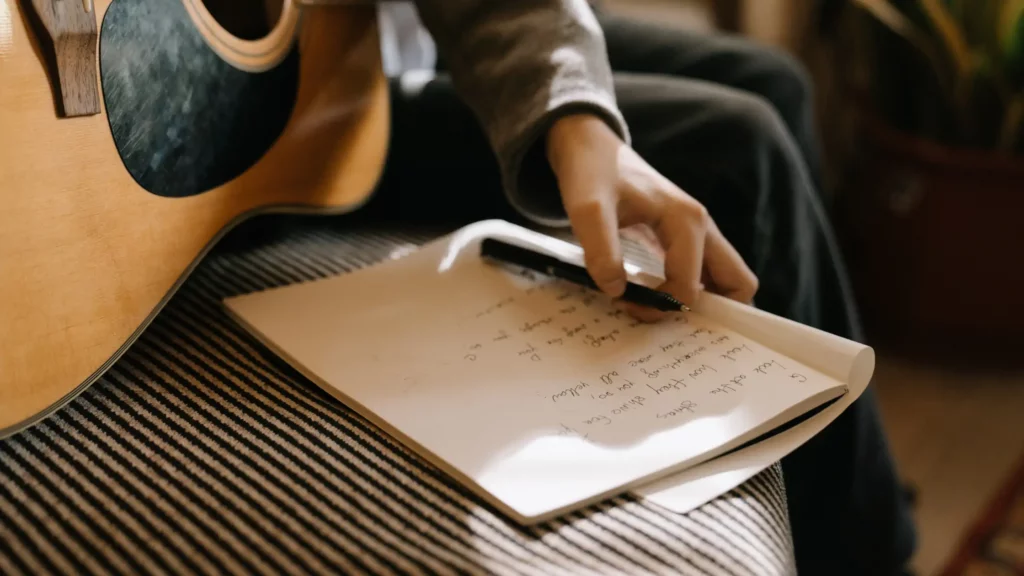Imagine you’re sitting with your instrument, a blank page before you, and a multitude of ideas swirling in your head. The task of weaving these into a coherent and catchy song can be daunting. This is where word-based songwriting prompts come into play. They are simple yet powerful tools that can kickstart the creative process. By focusing on a single word, you can unlock a treasure trove of melodic and lyrical possibilities.
One effective method is exploring word associations. This can mean taking a word and jotting down everything that it brings to mind, be it emotions, images, or sounds. For example, if you choose the word ‘eclipse,’ you might think of darkness, mystery, transformation, or cycles. Each of these associated terms can serve as a new point of departure, offering different angles to approach your songwriting.

Overcoming writer’s block often comes down to having a clear starting point. Word prompts are excellent in this regard. They act as a creative nudge that helps you begin piecing together a narrative or mood for your song. You may pull these words from reading material, overheard conversations, or even dedicated songwriting prompt lists found online or in books.
Let me offer you a few examples of word prompts that could launch your next songwriting session: ‘Whisper,’ ‘Horizon,’ ‘Fragments,’ ‘Velocity.’ Each word holds within it the seeds of a story or a mood, waiting for you to cultivate it into a song. Try picking one and watch as your inspiration starts to flow.
Related Posts:
- Write Better Songs Faster – Hookpad’s Revolutionary Approach To Hooks
- The Ultimate Guide To Creating A Concept Album
- Song Arrangement And Structure Tips You Will Love
Harnessing the Emotive Force of Poetic Imagery
Poetic imagery isn’t just for poets; it’s a songwriting gold mine. Images painted with words pull listeners into a song, anchoring them in a moment that feels both intimate and expansive. So, how can you leverage this in your songwriting? Think of a powerful image from your life or imagination, then distill it into a line that evokes emotion or tells a story. For instance, envisioning ‘a sun-bleached pier, abandoned at dusk’ can conjure a sense of solitude and change.
The art of crafting lyrics that resonate lies in the ability to tap into sensory experiences. When you speak of how the ‘morning air tastes of a brewing storm,’ you invite listeners to share the experience, to feel the electricity of an impending tempest. The senses are pathways to the emotions, and by engaging them, you create a bond between your song and the listener’s own life.

To begin shaping your song with imagery, focus on a single scene and identify the key sensory details within it. Write these down, play with adjectives, and consider metaphors that amplify the emotion. As you refine this process, your songs will transform into more than just melodies; they’ll become vivid experiences that listeners can step into.
Here’s a practical exercise: Choose an image such as ‘rain against the windowpane,’ and write down every associated feeling and thought. How does it sound, look, or even smell? How does it make you feel? From this brainstorming, you can extract a few poignant lines that capture the essence of the image, setting the stage for emotionally charged lyrics.
Sculpting Songs from Life Experiences
I often find that the most resonant songs stem from the soil of genuine life experiences. Our personal stories and memories are rich mines for material that can connect with listeners on a profound level. When we channel these truths into our music, we’re not just creating; we’re communicating.
Crafting a compelling song often involves peeling back the layers of our own stories to reveal relatable lessons and emotions. While the experiences are uniquely ours, the sentiments they evoke—joy, loss, love, ambition—are universal. It’s this balance between the particular and the universal that strikes a chord with audiences.

I’ve found that the authenticity of a song grounded in real experiences can be its strongest asset. There’s a tangible authenticity that resonates when listeners detect the truth in your words—when they know you’re not just telling a story, but recounting your story.
But how do you craft a song that’s both intimately personal and broadly appealing? I recommend distilling your experiences into themes and emotions that are widely relatable. For instance, instead of singing about the specifics of your hometown, you might craft lyrics about the sense of belonging or nostalgia that your hometown evokes. This allows your audience to see their own lives reflected in your song, building a bridge between your experience and theirs.
Making the leap from personal anecdote to universal truth is a skill that you’ll refine with practice. In the next section, I’ll explore how adopting a thematic approach can provide clarity and direction for your songwriting process, bringing coherence to the stories you want to share.
Theme-Based Songwriting: Constructing a Conceptual Framework
I find the thematic approach to songwriting intriguing. It’s like choosing a color palette before painting; it sets the mood and guides your creative process. Exploring a single theme in depth can provide a clear direction for your song, helping you tell a more cohesive and impactful story.
When I talk about building an entire song around a central theme, I’m referring to using that theme as the backbone of your song. Every verse, every chorus, bridge, or instrumental interlude becomes another opportunity to delve into the theme, each from a different angle or perspective, bootstrapping greater insight and emotional depth as the song progresses.

Maintaining thematic consistency is more than just a creative choice; it’s a way to give your listeners a focused experience, where they can connect to the narrative and the essence of what you’re trying to convey. This consistent thread throughout the song not only makes the writing process more straightforward but also makes the song more memorable for the audience.
Take a moment to consider songs that have remained etched in your memory. There’s a high chance they revolve around strong, clearly defined themes. Whether it’s love lost, social upheaval, personal triumph, or introspective reflection, these themes are explored with precision and a depth of feeling that can resonate on a universal level.
I stick to the guiding principle that solid, theme-rich content is both accessible and meaningful. This kind of songwriting invites listeners into a specific world or emotion, making the song relatable and deepen their connection to the music.
Interactive Prompts: Engaging with Your Audience to Shape Content
When the usual songwriting methods seem a bit stale, turning to interactive prompts can add a new dimension to your creative process. Social media platforms offer you direct access to your audience, making them a treasure trove for fresh ideas. You might create a song from a title suggested in a comment or develop a concept based on a shared experience offered by your followers.
This approach doesn’t just serve the purpose of generating ideas; it also fosters a deeper connection between you and your listeners. The songs that spring from these interactions tend to resonate with added authenticity, as they reflect not just your voice, but the collective voice of those who support your music.
Take a look at some successful musicians who have pioneered this approach, getting fans involved in everything from lyrics to music video concepts. Their work often gains additional traction as the audience takes ownership and pride in the collaborative effort.
Remember, involving your audience is about more than just sourcing material – it’s about building a community around your music. By showing your fans that their voices matter, you’re not just crafting songs, you’re nurturing relationships that can lead to lifelong support and inspiration.
Related Posts:





Leave a Reply